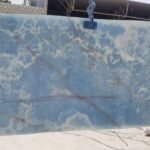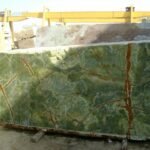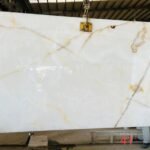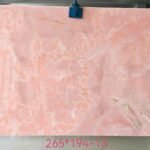Lapis Lazuli Stone Knife Handle
A “Lapis Lazuli Knife Handle” refers to a knife handle that incorporates lapis lazuli gemstone into its design. While lapis lazuli is not suitable for use as the knife blade due to its relatively soft nature, it can be used to create beautiful and ornamental knife handles.
Here’s how lapis lazuli can be used as a knife handle:
Decorative Inlays: Lapis lazuli can be cut and shaped into small pieces to serve as decorative inlays on the knife handle. These inlays can be embedded into the handle material, creating a striking contrast and adding a touch of elegance to the overall design.
Full Handle Cover: In some cases, artisans may create knife handles entirely from lapis lazuli, covering the entire handle with the gemstone. However, this type of handle is more commonly found in decorative or display knives, as lapis lazuli’s softness makes it less practical for everyday use.
Combined with Other Materials: Lapis lazuli can be combined with other handle materials like wood, bone, or metal to create a hybrid design. This allows the knife to have both the unique beauty of lapis lazuli and the durability of other materials.
It’s worth noting that while lapis lazuli knife handles can be visually stunning, they are typically used for decorative or collector’s purposes rather than practical daily use. Lapis lazuli is a valuable gemstone, and knife handles made from this stone are more likely to be found in custom or artisanal knife creations rather than mass-produced commercial knives.
If you’re interested in obtaining a knife with a lapis lazuli handle, it’s best to explore specialty knife makers, custom artisans, or boutique shops that specialize in high-end and artistic knives. Always ensure that the knife is crafted with attention to detail and functionality, even if it’s intended primarily for display or collector’s purposes.
Physical Properties of Lapis Lazuli
Classification A metamorphic rock that contains enough of the mineral lazurite to impart a distinct blue color. It may also contain significant amounts of calcite, pyrite, and minor amounts of other minerals.
Color Blue. Often with white calcite veining or mottling, and gold grains of pyrite.
Streak Blue.
Luster Dull, but polishes to a bright luster.
Diaphaneity Semi-translucent to opaque.
Cleavage None, though it may split easily along foliation or calcite veins and layers.
Mohs Hardness Varies between the 3 of calcite and the 5 to 5.5 of lazurite. Not well suited for use as a ring stone or in bracelets.
Specific Gravity 2.7 to 2.9 or more depending upon the amount of pyrite
Diagnostic Properties Blue color, association with pyrite, and hardness.
Uses Cabochons, beads, carvings, spheres, inlay, and pigments.























